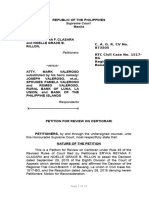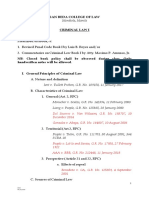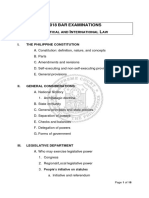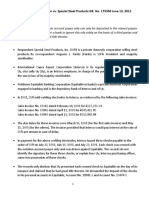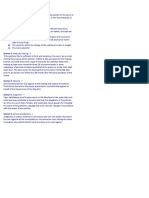0 ratings0% found this document useful (0 votes)
184 viewsAssignment Evidence
This document outlines assignments for a 5-day course on evidence law. Day 1 assignments cover key concepts like the definition of evidence, the scope and distinctions between civil and criminal evidence rules, and the admissibility of evidence. Day 2 assignments distinguish burdens of proof/evidence and address presumptions. Day 3 covers judicial notice/admissions. Day 4 addresses real/demonstrative evidence and DNA evidence. Day 5 assignments cover documentary evidence rules including best evidence and exceptions, electronic evidence rules, and the parol evidence rule.
Uploaded by
Anonymous wDganZCopyright
© © All Rights Reserved
Available Formats
Download as DOCX, PDF, TXT or read online on Scribd
0 ratings0% found this document useful (0 votes)
184 viewsAssignment Evidence
This document outlines assignments for a 5-day course on evidence law. Day 1 assignments cover key concepts like the definition of evidence, the scope and distinctions between civil and criminal evidence rules, and the admissibility of evidence. Day 2 assignments distinguish burdens of proof/evidence and address presumptions. Day 3 covers judicial notice/admissions. Day 4 addresses real/demonstrative evidence and DNA evidence. Day 5 assignments cover documentary evidence rules including best evidence and exceptions, electronic evidence rules, and the parol evidence rule.
Uploaded by
Anonymous wDganZCopyright
© © All Rights Reserved
Available Formats
Download as DOCX, PDF, TXT or read online on Scribd
You are on page 1/ 2
ASSIGNMENT FOR DAY ONE
1. Explain the concept of evidence
2. Scope of the Rules on Evidence
3. Distinctions between the Rules of Evidence in Civil cases versus Evidence in
Criminal Cases
4. Proof versus Evidence
5. Factus Probans versus Factus Probandum
6. Admissibility of Evidence
a. Requisited for Admissibility of Evidence
b. Relevance of Evidence and Colalteral matters. Give example
c. What does Multiple Admissibility mean?
d. What is Conditional Admissibility?
e. What is Curative Admissibility?
f. Direct and Circumstantial evidence
g. Positive and Negative evidence
h. Competence (Competent) and Credible evidence
ASSIGNMENT FOR DAY TWO
1. Distinguish Burden of Proof and Burden of Evidence
a. Define Presumptions
b. What is Conclusive Presumption
c. What are the Conclusive Presumptions
d. What is Disputable Presumption?
2. What is a Liberal Construction of the Rules of Evidence?
3. Quantum of Evidence (weight and sufficiency of evidence)
a. When Proof beyond reasonable doubt required?
b. What is Preponderance of Evidence?
c. What is Substantial evidence?
d. What is Clear and Convincing evidence? When is it required?
ASSIGNMENT FOR DAY THREE
1. Distinguish judicial notice and judicial admissions
a. When need not be proved
b. What are matters of judicial notice?
c. What are judicial admissions
i. Effect of judicial admissions
d. How admissions may be contradicted
e. Rules on judicial notice of foreign laws, law of nations and municipal
ordinance
ASSIGNMENT FOR DAY FOUR
1. Object (Real) evidence
a. Nature of object evidence
b. Requisites for admissibility
c. Categories of object evidence
d. What is Demonstrative evidence?
e. When is view of an object or scene required?
f. What is Chain of custody, in relation in Sec. 21 of the Comprehensive
Dangerous Drugs Act of 2002?
2. Explain Rule on DNA Evidence (AM No 06-11-5-SC)
ASSIGNMENT FOR DAY FIVE
Documentary Evidence
1. Meaning of documentary evidence
2. Requisites of admissibility
3. Best evidence rule
a. Meaning of the rule
b. When applicable? Exceptions?
c. Meaning of the original?
d. Requisites for introduction of secondary evidence under (a) of Sec 3
Rule 130
e. In cases under (b) Sec 3, Rule 130
4. Rules on Electronic Evidence (AM No. 01-7-01-SC)
a. Scope; coverage, meaning of electronic evidence; electronic data
message
b. Probative value of electronic documents or evidentiary weight; method
of proof
c. How to authenticate electronic documents and electronic signatures
d. Electronic documents vis-a-vis the hearsay rule
e. Audio, photographic, video and ephemeral evidence
5. Parol Evidence Rule
a. Application of the parol evidence rule
b. When parol evidence can be introduced
c. Distinctions between the best evidence rule and parol evidence rule
You might also like
- D.M. Armstrong - Nature of Mind-Harvester Press (1981)No ratings yetD.M. Armstrong - Nature of Mind-Harvester Press (1981)187 pages
- Be It Enacted by The Senate and House of Representatives of The Philippines in Congress Assembled100% (1)Be It Enacted by The Senate and House of Representatives of The Philippines in Congress Assembled5 pages
- Set Menu: Aristocrat All-Time Favorites Aristocrat Best Sellers0% (1)Set Menu: Aristocrat All-Time Favorites Aristocrat Best Sellers2 pages
- Concept Analysis As A Method of Inquiry: Issues in ResearchNo ratings yetConcept Analysis As A Method of Inquiry: Issues in Research10 pages
- Cindy Fernandez Criminal Justice SystemNo ratings yetCindy Fernandez Criminal Justice System13 pages
- University of Perpetual Help Evidence 2021 Mid Term Examinations Direction: Choose The Letter of The Best AnswerNo ratings yetUniversity of Perpetual Help Evidence 2021 Mid Term Examinations Direction: Choose The Letter of The Best Answer6 pages
- A. Course Description: St. Peter's College Sabayle ST., Iligan City College of Criminology SyllabusNo ratings yetA. Course Description: St. Peter's College Sabayle ST., Iligan City College of Criminology Syllabus2 pages
- IMPLEMENTING RULES AND REGULATIONS Republic Act No 10586No ratings yetIMPLEMENTING RULES AND REGULATIONS Republic Act No 1058611 pages
- Certification of Expenses Not Requiring ReceiptsNo ratings yetCertification of Expenses Not Requiring Receipts1 page
- Verification and Certification of Non-Forum Shopping: Doc No. - Page No. - Book No. - Series of 2018No ratings yetVerification and Certification of Non-Forum Shopping: Doc No. - Page No. - Book No. - Series of 20181 page
- Vicente Del Rosario y Nicolas, Petitioner, vs. People of The PhilippinesNo ratings yetVicente Del Rosario y Nicolas, Petitioner, vs. People of The Philippines13 pages
- Application For Probation With Motion For The Release of The Accused On RecognizanceNo ratings yetApplication For Probation With Motion For The Release of The Accused On Recognizance2 pages
- CRIMINAL PROCEDURE and COURT TESTIMONY1No ratings yetCRIMINAL PROCEDURE and COURT TESTIMONY176 pages
- Justice Leonen's Dissenting Opinion On Juan Ponce Enrile Vs Sandiganbayan, and People of The Philippines G.R. No 213847100% (3)Justice Leonen's Dissenting Opinion On Juan Ponce Enrile Vs Sandiganbayan, and People of The Philippines G.R. No 21384729 pages
- Selected Board Question Last: December 2018 CLE)No ratings yetSelected Board Question Last: December 2018 CLE)51 pages
- Counter Affidavit Complainant For Serious Physical Injuries and Grave PDF FreeNo ratings yetCounter Affidavit Complainant For Serious Physical Injuries and Grave PDF Free5 pages
- 2018 BAR Examinations P I L: Olitical and Nternational AWNo ratings yet2018 BAR Examinations P I L: Olitical and Nternational AW100 pages
- Condominium Buyers' Protective Decree) - Mr. Abbas, RafsanjanieNo ratings yetCondominium Buyers' Protective Decree) - Mr. Abbas, Rafsanjanie5 pages
- Be It Enacted by The Senate and The House of Representatives of The Philippines in Congress Assembled: First Name or NicknameNo ratings yetBe It Enacted by The Senate and The House of Representatives of The Philippines in Congress Assembled: First Name or Nickname2 pages
- RULE 103 Change of Name Section 1. Venue.No ratings yetRULE 103 Change of Name Section 1. Venue.3 pages
- Oropesa Vs Oropesa G.R. No. 184528 April 25, 2012 Case DoctrineNo ratings yetOropesa Vs Oropesa G.R. No. 184528 April 25, 2012 Case Doctrine1 page
- Secondary Curriculum & Instruction - Final (New)100% (2)Secondary Curriculum & Instruction - Final (New)165 pages
- The Science and Practice of Case Conceptualization100% (1)The Science and Practice of Case Conceptualization12 pages
- Midterm Exam - Philo of Language - Codename RaulNo ratings yetMidterm Exam - Philo of Language - Codename Raul10 pages
- Norman Geisler - A Defense of Biblical Miracles - 02No ratings yetNorman Geisler - A Defense of Biblical Miracles - 028 pages
- Underdetermination: Ojimar Sj. Julian Ph. D. Science EducationNo ratings yetUnderdetermination: Ojimar Sj. Julian Ph. D. Science Education35 pages
- Pengembangan Bahan Ajar Berbasis Multimedia Pada Pembelajaran Stoikiometri Nurhidayah, K. Anom W., Diah Kartika SariNo ratings yetPengembangan Bahan Ajar Berbasis Multimedia Pada Pembelajaran Stoikiometri Nurhidayah, K. Anom W., Diah Kartika Sari8 pages
- Van Til's Insights On The Trinity: Ralph Allan SmithNo ratings yetVan Til's Insights On The Trinity: Ralph Allan Smith19 pages
- Final Handouts Quantitative research Soc 509-No ratings yetFinal Handouts Quantitative research Soc 509-172 pages
- Scientific Method and Sources of KnowledgeNo ratings yetScientific Method and Sources of Knowledge3 pages
- A Semiotic Theory of Mathematical Text: Paul ErnestNo ratings yetA Semiotic Theory of Mathematical Text: Paul Ernest35 pages






























